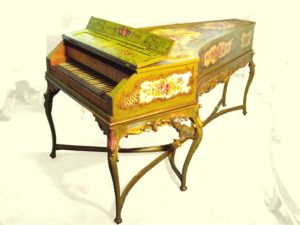Franz Xaver Christoph c. 1780 – 1785
Description

| Date: | 1780 |
| Origin: | Vienna |
| Serialnumber: | --- |
This unique and extraordinary fortepiano is one of the earliest preserved fortepianos of the 18th century from Vienna. Vienna was next to Paris and London one of the main cities of piano making. In addition to Anton Walter, the organ and piano builder Franz Xaver Christoph was one of the best instrument makers in Vienna.
This fortepiano is decorated in Rococo style and has various rocailles fields with richly floral paintings. The case is flat without plastic decorative elements. The filigree frame construction has carved ornaments on the sides, which lead over five curved legs. The five legs are connected 6-9 cm above the ground with filigree curved footbridges. In the centre of the bridge, it has an attached oval ornamental element, edged with carved acanthus leaves. The hinged three-leaf lid is attached to the back of the case with three hinges. The lid itself consists of six grooved fillings, which are slightly recessed on the inside, and through the raised frieze, the surface is divided; this in contrast to the outer surface, which forms a smooth surface. The instrument was not originally painted and had no frame base, but five legs, which were screwed into the case.
Before the piano was painted in two different stages, the surface was treated dark brown.
1st version:
There was a red basic colour with gilded bands and tendril ornaments on the case and frame.
2nd version:
About the red version came a chalk foundation for the following tempera painting with green colour base around the 15 gilded rocailles fields with filigree internal drawing. In that area it has floral motifs in colourful colours on a white background. The lid is painted green on the inside; in the six fields it has analogous outside floral motifs, which are also bordered in the two largest fields with line and acanthus tendrils. Over the cover friezes are leaves. On the green frame, the carved decoration in different shades yellow, red, blue and set with gilding.
The entire painting and decoration is of outstanding quality and made with highest artistic skills and taste and has been restored by a professional restorer for painting in Switzerland.

Fortepiano by Franz Xaver Christoph, Vienna c. 1780 (closed lid) – Eric Feller Collection
The instrument is unsigned but shows in all structural details features that it is clearly attributed to Franz Xaver Christoph. The piano has a compass of 5 octaves (FF – f3) and the keyboard is made of ebony and bone. The instrument features a Viennese Stoßzungenmechanik with forward facing hammers, Stiefeldämpfung and non divided bridge. On the underside of the keys are brass capsules with wire eyelets (in older instruments, these eyelets are made of gut string loops). A knee lever is controlling the dampers and in the middle of the nameboard is a hand stop for controlling a moderator stop.

Fortepiano by Franz Xaver Christoph, Vienna c. 1780 (Keyboard) – Eric Feller Collection
About Franz Xaver Christoph is only little known. He was born in Vienna in 1733 and was christened on 1 December 1733. He is today known as one of the best organ and piano makers in Austria in the 18th century. It is likely that he spent part of his education abroad. The first proven organ dates from 1768. It is the organ of the parish church Oberlaa / Vienna.
In 1776 one of his most important baroque organs was completed, the organ in the pilgrimage church Sonntagberg at Ybbs. His business was at Wieden No. 59 in Vienna. From 1777 to 1793 he received money for maintenance of the organs in the cathedral of St. Stephen in Vienna. 1784/85 he took over repairs to the Füchsel-Baldachin-Organ. From 1785 to 1788 he supervised the organ in the church of St. Michael in Wieden, which was also renovated by him in 1785. His pupil was Ignaz Kober (1755 – 1813). He continued Christoph’s work and brought it to perfection. On April 18th 1793 Franz Xaver Christoph died in Windmühle. After his death, Franz Hubert (around 1770 – 1810), who came from Bratislava, took over the business after he had married Christoph’s second wife Cäcilie Geill (1751 – 1807).
Further research to this instrument is still ongoing!
Further preserved instruments by Franz Xaver Christoph:
- 1785/90 combination instrument organ & square piano – Kunsthistorisches Museum, collection of old musical instruments, Vienna, Austria (click here)
- 1790 square piano -Muzej za umjetnost i obrt, Zagre, Croatia
| Length: | 205 cm |
| Width: | 104,5 cm |
| Height: | 24,5 cm |
| Circumference: | 5 octaves (FF – f3) |
| Mechanics: | Viennese "Stoßzungenmechanik" |
| Pedals: | 1 knee lever (dampers), 1 hand stop (moderator) |
| Signature: | --- |

